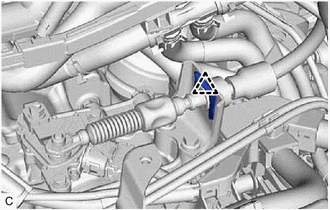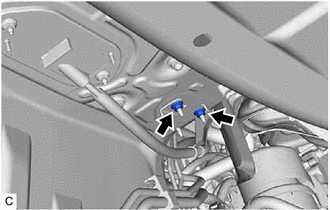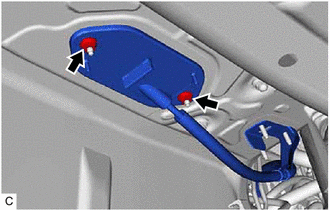Lexus ES: Removal
REMOVAL
CAUTION / NOTICE / HINT
The necessary procedures (adjustment, calibration, initialization or registration) that must be performed after parts are removed and installed, or replaced during transmission control cable assembly removal/installation are shown below.
Necessary Procedures After Parts Removed/Installed/Replaced| Replaced Part or Performed Procedure | Necessary Procedure | Effect/Inoperative Function when Necessary Procedure not Performed | Link |
|---|---|---|---|
| Battery terminal is disconnected/reconnected | Perform steering sensor zero point calibration | Lane Control System (for Gasoline Model) | |
| Pre-collision System (for Gasoline Model) | |||
| Parking Support Brake System (for Gasoline Model)*1 | |||
| Lighting System (for Gasoline Model) | |||
| Memorize steering angle neutral point | Parking Assist Monitor System (for Gasoline Model) | | |
| Panoramic View Monitor System (for Gasoline Model) | | ||
| Initialize power trunk lid system | Power Trunk Lid System (for Gasoline Model) | | |
| Replacement of ECM | Vehicle Identification Number (VIN) registration | MIL comes on | |
| ECU communication ID registration (Immobiliser system) | Engine start function | | |
| Replacement of ECM (If transaxle compensation code read from ECM) |
|
| for Initialization: for Registration: |
| Replacement of ECM (If transaxle compensation code not read from ECM) |
| ||
| Replacement of ECM | Code registration (Smart access system with push-button start (for Start Function, Gasoline Model) |
| |
| Gas leak from exhaust system is repaired | Inspection after repair |
| |
-
*1: When performing learning using the Techstream.
Click here
.gif)
- *2: Not necessary when ECM replaced with new one.
PROCEDURE
1. REMOVE BATTERY
Click here .gif)
2. REMOVE ECM
Click here .gif)
3. REMOVE BATTERY CLAMP SUB-ASSEMBLY
Click here .gif)
4. REMOVE FRONT EXHAUST PIPE ASSEMBLY
Click here .gif)
5. REMOVE FRONT LOWER NO. 1 FLOOR HEAT INSULATOR
| (a) Remove the 2 nuts and front lower No. 1 floor heat insulator from the vehicle body. |
|
6. REMOVE TRANSMISSION FLOOR SHIFT ASSEMBLY
Click here .gif)
7. REMOVE NO. 1 CONSOLE BOX DUCT
| (a) Remove the No. 1 console box duct. |
|
8. REMOVE TRANSMISSION CONTROL CABLE ASSEMBLY
| (a) While disengaging the clip as shown in the illustration, disconnect the transmission control cable assembly from the transmission control shaft lever together with the clip. |
|
| (b) Remove the clip and disconnect the transmission control cable assembly from the No. 1 transmission control cable bracket. |
|
| (c) Remove the 2 nuts and disconnect the transmission control cable assembly from the vehicle body. |
|
| (d) Remove the 2 nuts and then remove the transmission control cable assembly from the vehicle body. |
|

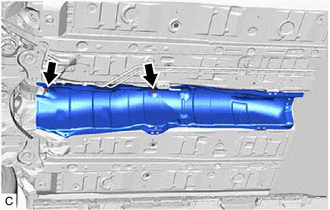
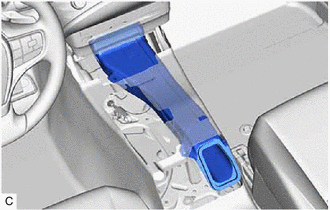
.png)
